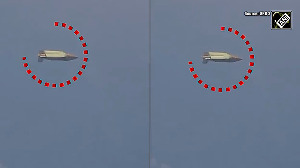 Seven years after it was acquired by Tata Steel, Corus (now called Tata Steel Europe) is not out of the woods, in spite of talk that Europe is gradually coming out of its six-year-long recession.
Seven years after it was acquired by Tata Steel, Corus (now called Tata Steel Europe) is not out of the woods, in spite of talk that Europe is gradually coming out of its six-year-long recession.
This became clear when Tata Steel announced its financial results for the quarter ended March 2014.
Tata Steel Europe's Ebitda (earnings before income tax depreciation and amortisation) has increased year-on-year but fallen sequentially (see table).
Similarly, its net loss has come down from the year-ago quarter but increased over the previous quarter.
What worries analysts is that this has happened even though Tata Steel Europe has reported a sharp rise in turnover and production both year-on-year and sequentially.
This can only mean that its per-tonne sales realisation has reduced. Is the company losing pricing power in a buoyant market?
If that is true, the company has serious reason for worry.
"Tata Steel Europe's performance was a big let-down because despite a sharp jump in production and deliveries, there was a sharp fall in margins, grossly underperforming its peer group," a report put out by Kotak Securities says.
According to the report, Tata Steel Europe saw inventory pileup of 1.69 million tonnes in 2013-14 versus 0.31 million tonnes a year ago, and that brought pricing pressure on the company.
Tata Steel Europe's average realisation fell 7.7 per cent sequentially, while raw material costs increased 0.1 per cent, which resulted in a massive 25.5 per cent sequential fall in Ebitda per tonne.
Compare this with ArcelorMittal's European operations which delivered a 23.2 per cent sequential improvement in Ebitda per tonne.
"The (Tata Steel Europe) management has attributed this fall to a correction in spreads between hot sheet prices and raw materials, but we believe that fears of further inventory accumulation seem to have led to aggressive prices which have in turn resulted in sharp fall in margins," the Kotak report adds.
While announcing the results, Karl-Ulrich Kohler, Tata Steel Europe's managing director & CEO, said that Europe was entering a phase of robust economic growth, which was supporting a recovery in steel demand. But analysts are sceptical.
"A large part of that is on account of higher consumer spending and home buys, which in turn has been caused by cheaper consumer credit. If there is a structural shift to a more sustainable economic performance is difficult to tell at this point in time," says a sector expert.
"The growth in infrastructure is yet to pick up. The same is true for automobiles. The population is stagnant and the feel good factor is not strong enough for the population to change to new models of cars. These (infrastructure and automobiles) are two main areas that drive consumption of steel," adds Tridibesh Mukherjee, former executive director of Tata Steel Europe.
An ICRA report in February had said that unless demand conditions improved significantly in Europe, overall capacity utilisation levels and profitability of steel players would remain low.
Problems galore
 While there may be a glimmer of hope in Europe, there are other worrying factors that could keep the steel market subdued, thinning the spreads between raw material and finished steel.
While there may be a glimmer of hope in Europe, there are other worrying factors that could keep the steel market subdued, thinning the spreads between raw material and finished steel.
Chinese steel prices have fallen from $530 a tonne at the beginning of the year to $515 a tonne.
"China is a key problem. Significant excess capacity in China may necessitate exports from the country, which will impact prices.
The scenario is not very conducive for the steel industry in the near term," ICRA Senior Vice-president Jayanta Roy says.
The country has excess capacity of 180-200 million tonnes and the Chinese government has set a target of bringing that down by 60 million tonnes by 2017; the target for this year is 28 million tonnes.
But that won't be enough to wipe out the excess capacity in that country, experts say. "China is exporting a fair quantity of steel-intensive products and commodity steel to Europe. In such a situation, the European steel companies cannot enjoy pricing power," Mukherjee, says.
This lack of pricing power has more than negated the benefits of falling raw material prices. Indeed, long-term coking coal contracts are at $125 a tonne for the April-June quarter, which is a six-year low.
Iron ore prices, too, have softened. Benchmark iron ore prices, which touched $97.50 a tonne last week, are at a two-year low. There is, however, some apprehension that with China moving to higher grade ore, prices of high grade ore could rise in the future.
Moreover, Tata Steel Europe, which accounts for 62 per cent of Tata Steel's consolidated production, did not have access to any captive raw material till recently.
That scenario, though, is changing somewhat. Tata Steel's post-results presentation to analysts mentions that some quantities of coking coal from its captive mines in Mozambique and iron ore from Canada were shipped during the last financial year.
Though the presentation did not mention the destination of these shipments, it is widely believed these were meant for Tata Steel Europe. But the quantities aren't large enough to make a significant impact on the bottom-line of Tata Steel Europe that makes 18 million tonne of steel per annum. (Iron ore and coking coal together account for around 80 per cent of the total input cost for steel.)
Another problem that faces most European plants is their outdated technology, many have not kept pace with the developing technology scenario.
As China emerged as the largest consumer of steel, the producers focused all their resources on it. Thus, the European plants got left behind not only in terms of technology but also scale because it was not viable to produce steel in Europe and ship it to China.
But they still have some advantages. "In the case of high-end specialty steel, European companies have an upper hand. They have the technology, and relatively modern facilities, though not as modern as those in China," Mukherjee says.
The problems were compounded by the fact that Tata Steel bought Corus at the peak of the commodity cycle at 608 pence a share, a premium of 34 per cent to the original offer price, to ward off a counter bid from Brazilian miner and steel maker CSN. But that's history now.
As Tata Steel Europe's Kohler said in 2012, the best thing for Tata Steel to do in Europe is to get fit and become an "all-weather" enterprise, rather than hope for market circumstances to improve as they can't be influenced.
That appears to be under implementation, as savings in operating costs for European operations reached £200 million in FY14.
Tata Steel's India performance during the March-ended quarter was a picture in contrast, with profit margins at a seven quarter high.
But that is consistent with the steel group's story ever since the $13-billion acquisition of Corus in 2007.
What has emerged from the deal, the largest foreign acquisition by an Indian company at that time, is that there exist two Tata Steels - the not-so happening part is in the developed world.












 © 2025
© 2025